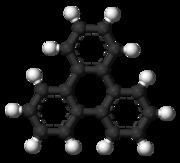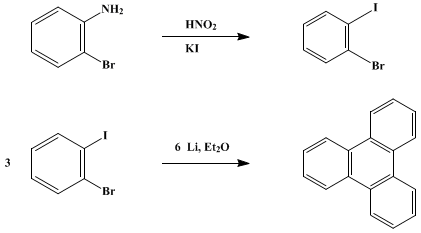Formula C18H12 | Boiling point 711 °C | |
 | ||
In chemistry, the organic compound triphenylene is a flat polycyclic aromatic hydrocarbon (PAH) consisting of four fused benzene rings. Triphenylene can be isolated from coal tar, but it is also made synthetically using benzyne chemistry, as it is a trimer of benzyne. One molecule of triphenylene has delocalized 18-π-electron systems based on a planar structure. It has the molecular formula C
18H
12.

Triphenylene is a fully benzenoid PAH, meaning its structure is composed only of full benzene rings interconnected by carbon–carbon single bonds. The three benzene rings can be drawn as the three outer rings, with the central ring formed by one face of each and the three carbon–carbon single bonds.

Being a fully benzenoid PAH means that triphenylene is much more resonance stable than its isomers chrysene, benz[a]anthracene, benzo[c]phenanthrene, and tetracene. This makes it much more difficult to hydrogenate to the saturated hydrocarbon.

In light of these characteristics, triphenylene may have uses in optics and electronics. Triphenylene is a disc-shaped molecule with a planar structure and three-fold rotation axes. Consisting of colorless needle-like crystals, it emits bluish purple fluorescence by UV irradiation.
In terms of its crystallographic point group, the symmetry of triphenylene is classified as D3h in Schoenflies notation. Because of these characteristics, six-fold (in the 2, 3, 6, 7, 10, and 11 positions) alkyloxy- or alkylthiol-substituted triphenylenes can be used as a discotic mesogen in liquid crystalline materials.
In February 2014, NASA announced a greatly upgraded database for tracking polycyclic aromatic hydrocarbons (PAHs), including triphenylene, in the universe. According to scientists, more than 20% of the carbon in the universe may be associated with PAHs, possible starting materials for the formation of life. PAHs seem to have been formed shortly after the Big Bang, are widespread throughout the universe, and are associated with new stars and exoplanets.
